Turtling in Junction Creek
What is Junction Creek?
Junction Creek is one of the most important water systems in Greater Sudbury. The creek flows from Garson, through New Sudbury, under the downtown core, travelling through the South End and flowing into Kelly Lake. Junction Creek continues through Walden and drains into the Vermilion River, which joins the Spanish River, and empties into Lake Huron.
Oversight of the creek health and well-being is facilitated by the Junction Creek Stewardship Committee (JCSC), which has been in operation since 1999. JCSC’s vision is for “a healthy and revitalized Junction Creek ecosystem.” Its mission? To “lead the way for improving and maintaining a healthy Junction Creek Watershed” – with four pillar principles to make that happen:
- Research & Monitor
- Restoration & Conservation
- Education & Awareness
- Connecting the Community
Since the committee’s inception, thousands of pounds of trash has been removed from the creek, and thousands of Brook Trout have been released into it. The creek has an unfortunate history of damage due to mining and logging practices, but its most recent years show a bounce back in the water system’s health.
In the past 23 years, over 84 000 kg (over 185 THOUSAND pounds) of trash has been removed from the creek, 38 000 trees and shrubs have been planted, and a whopping 18 species of fish now call the Junction Creek Watershed their home.
The Junction Creek Watershed refers to both the creek and the area of land that encompasses it. Its total size is approximately 32,900 hectares – or 81,297 acres.
Needless to say, there’s plenty of ground – and water - to cover when it comes to looking for turtles.
On the cusp of summer, in mid-June, Miranda Virtanen shares the best time of day to go turtling.
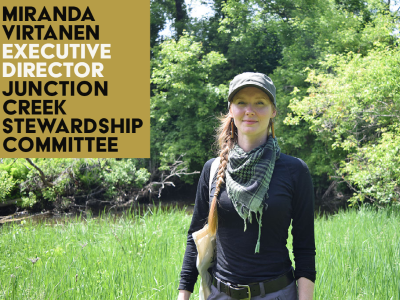
“The best time to see them is in the morning, after a cool night,” she says.
Miranda Virtanen is the Executive Director of the Junction Creek Stewardship Committee, a position she has held since 2018. She is an expert in the outdoors, bringing a wealth of education and experience to the role.
A graduate of both the Wildlife Biology & Conservation at the University of Guelph and the Conservation and Environmental Law Enforcement at Fleming College, Virtanen’s experience lies “primarily with reptiles, species at risk, and ongoing education programs, workshops, and environmental development,” she says.
It is plain to see that Virtanen is no stranger to turtles. In fact, she just co-authored a book on them.
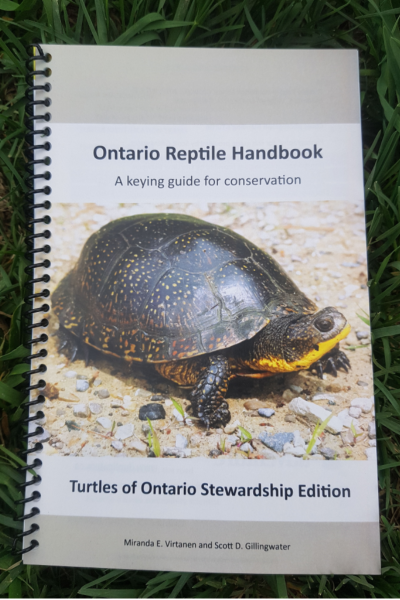
The Ontario Reptile Handbook: Turtles of Ontario Stewardship Edition
The Ontario Reptile Handbook: Turtles of Ontario Stewardship Edition is a comprehensive guide to the turtles that live in Ontario. Joining Virtanen in authorship is Scott D. Gillingwater, a Species At Risk Biologist with the Upper Thames River Conservation Authority.
The book features full-colour images, guides and diagrams to show the differences in turtle breeds across the province, as well as helpful information including what to do with an injured turtle, how to help turtles cross the road, and even how to become a turtle community scientist.
The handbook is incredibly helpful to anyone who enjoys the Ontario outdoors. You may find yourself picking it up as a casual turtle fan, using it to identify the different turtles you encounter, and leaving your copy as a permanent gear fixture in your day pack.
Bend it, fold it, roll it any way you like – this manual is printed on versatile, durable waterproof paper with a spiral binding.
The book’s incredible content, both in pictures and words, make it a no-brainer for anyone looking to expand their knowledge on the turtle population in Ontario.
What Turtles Live In Junction Creek?
Ontario is home to nine different turtle species, and three of those are hardy enough to live year-round in Junction Creek. These species are the Blanding’s Turtle, Midland Painted Turtle, and Snapping Turtle.
We broke down the differences in identifying the turtles in the creek from afar.
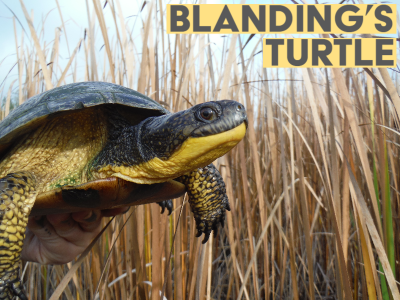
Blanding’s Turtle
This medium-sized turtle is “approximately the size of a dinner plate,” says Virtanen, “They’re more oval, similar to a helmet.”
The Blanding’s Turtle was first discovered in Junction Creek in 2011, making them one of the more recent residents of the water system.
This turtle is considered to be endangered under the Federal Species at Risk Act. Their population has declined more than 60% over the past 120 years, prompting conservation efforts.
Their trademark feature is their bright yellow chin and throat, with its mouth upturned in a grin.
“That’s easy to spot from a distance or in water, when their heads are just poking up,” she says.
In addition to their yellow markings, another way to identify a Blanding’s Turtle is from its shell shape.

Their top shell – also known as a carapace - is highly-domed, smooth, and is flecked with white and yellow spots.
Although these are tiny turtles, growing to an approximate length of 23 cm, they can live to be over 100 years old – they show little signs of aging, and can continue producing eggs well into their nineties, says Virtanen.
These turtles are the most-travelled of the three in Junction. They often travel considerable distances, searching for food and the perfect nesting spot – “they’re very terrestrial, and are able to travel considerable distances from their wetland of origin during nesting migrations, with movements of 6 kilometres,” Virtanen says, showing that size does not always matter when it comes to the wanderlust lifestyle.
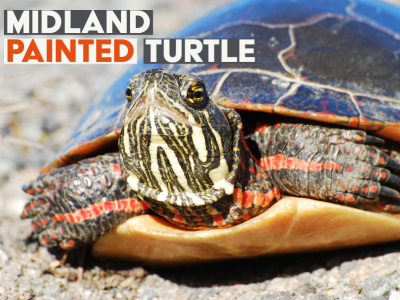
Midland Painted Turtle
The tiniest turtle in the creek, these fast turtles will grow to approximately 14 cm (5.5 in).
The midland painted turtle is one of three subspecies of painted turtles in Canada.
These turtles are considered to be the most abundant turtle species in North America and can live upwards of 55 years.
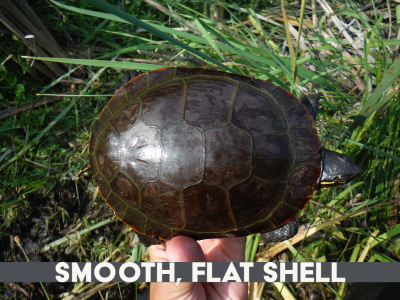
Midland painted turtles “look like they were run through paint,” says Virtanen, aptly describing the red-and-orange stripes on their neck and legs, and the yellow brush streaks adorning their faces.
They have a flat, smooth carapace with red barring and blotches along the bottom edges.
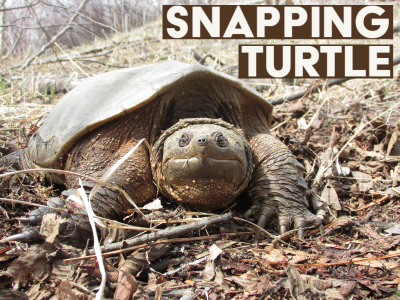
Snapping Turtle
Common snapping turtles are the largest turtle you will find in Junction Creek. This large breed can grow to a length of 50 cm (20 in) and are one of the heaviest turtles in Canada, weighing up to 10 kg (22 lbs).
Snapping turtles have large, sharp claws that are used primarily for digging and climbing.
The snapping turtle’s hooked upper jaw can chomp with an average bite force approximately 226 Newtons, or 50 pounds of force.
“Snapping turtles eat a lot of things that are dead, which makes them almost like the custodians of the wetlands,” Virtanen says.
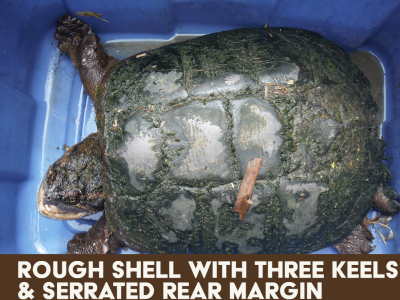
Although they eat mostly dead matter at the bottoms of lakes, these turtles are “fairly opportunistic.” According to Virtanen, “sometimes you hear about them grabbing frogs or small ducks out of the water.”
Snapping turtles can live a long time – “they can get over 100 years old,” Virtanen says, “I’ve even heard of some snapping turtles that are known to be over 150 years old”
If a snapping turtle turned 150 today, that would mean they were born in 1872 – making them older than the City of Sudbury itself.
How Are These Turtles Doing In The Creek?
“From 2011 to recent memory, the population is increasing,” says Virtanen.
Anecdotal evidence points to a healthier creek compared to decades prior. “We are getting more vegetation, which is great for the soil […] entire ecosystems are slowly getting better, which is having a positive impact on the turtles,” Virtanen says.
Turtles benefit from all kinds of wetland features, including beaver dams – a dominant structure of the Junction Creek water system.
“Beavers create dams, which in turn creates wetland systems that are great for turtles,” Virtanen explains, “You’ll see those forming within Junction Creek or some of the tributaries”.
How Do These Turtles Survive Sudbury Winters?
Virtanen says that although they haven’t studied every inch of the creek for turtle hibernation spots, they have an idea where they could be hiding.
“They hibernate in the wetlands along the creek,” Virtanen says, “we know of some hibernation sites within the Ponderosa wetlands, which the creek flows through.”
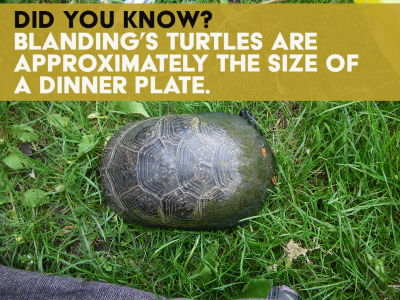
Turtles live underneath the surface while they hibernate in winters, and will continue to mosey around under the water, so long as it isn’t frozen.
“When the temperature of the water reaches four degrees, it is at its densest, so as long as it doesn’t completely freeze it’s fine,” she says, adding that turtles are “ectothermic,” which means that turtles can regulate their body temperature by exchanging heat with its surrounding environment.
“In colder temperatures, they will be slower; it will also slow down their metabolism and the amount of oxygen they will need will be reduced, so they mostly just mosey around underneath the ice, or bury themselves in the substrate.”
Check out a video from the Ottawa Citizen showing Northern map turtles under the ice!
Looking For Turtles In The Creek
Virtanen explains that the best way to observe turtles is from a distance – “you want to make sure you give it a lot of space,” she explains, “especially when they are nesting.”
Turtles in Junction Creek have an active nesting season in the June and July months. Turtles tend to disappear from view if you get too close, choosing to stay away from humans.
“The [best time of day] to see turtles is in the morning, after it’s been a cool night, and getting sunny and warm.”
Virtanen goes on to say that turtles like to warm in the sun, an activity called “basking”. Turtles bask to regulate their internal temperature, to absorb UVB light, and to dry out.
Turtles can often be seen basking on logs or rocks along the creek, using the structure to warm their bottom shell, also known as a plastron.
Virtanen recommends bringing a good set of binoculars, or a camera with a zoom lens in order to safely view the turtles.
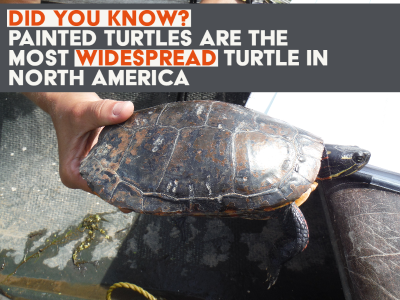
How Can We Help Turtles At Home?
“If you have your own pond, you can put some features in such as basking logs or platforms for them to go up on to bask in the sun,” Virtanen adds, “there are good ways to help create and encourage that habitat and give some good viewing opportunities as well”.
Virtanen also explains we are impacting the watershed in other ways, such as “using pesticides or other contaminants,” she explains, “They run off of your lawns and driveway, and into storm drains. That would then enter the creek and connected waterways in the watershed.”
Disposable plastic bottles, wrappers and bags are major creek pollutants. Making mindful choices, such as using reusable bags and bottles, contributes indirectly to a healthier water system.
Here’s a few more “creek-friendly practices” from the JCSC:
- Rainwater only down storm drains
- Avoid using pesticides and chemical fertilizers
- Choose non-toxic household products
- Pick up after your pets
- Fix leaks that drip from your vehicle
- Do not litter and secure loose garbage from blowing away
How Can We Help Turtles In The Outdoors?
“Road mortality is a huge conservation threat, as well as habitat loss,” Virtanen says.
According to the Ontario Turtle Conservation Centre, the cause of global turtle population decline is due to the following:
- Habitat loss and fragmentation
- Road mortality
- Poaching for the pet and food trades
- Boating mortalities and fishing by catch
- Predation of eggs by predators inadvertently supported by human populations (such as raccoons).
The loss of one adult female turtle can impact the population, Virtanen explains.
“A lot of turtles are at risk because of their life history,” she states.
Because turtles have such long life spans, it can take a couple decades before they reach sexual maturity.
“Turtles need to reproduce year after year, because their hatchlings tend to get eaten by everything”
Virtanen shared a sobering fact – that less than 1 out of every 100 eggs actually survive and make it to adulthood.
If you encounter a sick or injured turtle in the wild, Virtanen says to get in touch with the Turtle Pond Wildlife Centre in Sudbury, or your local wildlife custodian.

How Does Community Science Help The Turtles?
Documenting sightings is a great way to help “fill in the scientific data gaps,” says Virtanen.
“There’s lots of great apps out there, like iNaturalist, that you can download for free on your phone. When you are going out turtling, you can just take a picture of the turtle in the app, and it will get your GPS coordinates to submit,” says Virtanen, “You don’t even have to know the name of the species – it will identify it for you.”
“That data gets sent to a database that a bunch of different research programs can access.”
Are You Ready To Start Turtling?
Turtles are cute, fun, and love the sun. Most importantly, they are integral to the creek’s ecosystem.
It is more important than ever to protect our water systems. It is important to have this protection at the governmental level, but many preventative measures could be taken in our day-to-day that would have an impact on Junction Creek’s health.
Turtles are some of the world’s oldest creatures, and their populations are declining rapidly worldwide. It is suggested that if the rate of population decline continues, then turtles will become extinct in just a few centuries.
It is important to recognize that every individual has the ability to change this fact, by making proactive turtle choices in the future.
Recognizing and identifying turtles and making small adjustments to your daily routine will positively impact the turtles in Junction Creek for a lifetime.
Quick Facts
- Junction Creek is 32,900 hectares. According to the Ontario government, the province is home to approximately 23-29 million hectares of wetlands, making up approximately 25% of the country’s wetlands, and 6% of the Earth’s wetlands. This means that the Junction Creek wetlands accounts for 0.1% of Ontario’s wetlands, 0.04% of Canada’s wetlands, and 0.0085% of the world’s wetlands.
- Blanding’s Turtles are also cutely referred to as “Ontario’s smiling turtles” for its face shape.
- There are approximately 320 species of turtles in the world.
- Junction Creek’s length is approximately 52 km.
- It’s free to sign up as a Junction Creek member with the committee.
- Painted Turtles have been around a long time – in fact, some fossils show that they were around on Earth 15 million years ago.
Check out our infographic! This information is designed to quickly discern the differences between Junction Creek's turtle species.

This article was written by Kallie Berens-Firth. Pictures of turtles provided by Junction Creek Stewardship Committee.
Resources:
Junction Creek’s Annual Report 2019 – A fantastic visual report made by Junction Creek Stewardship Committee, highlighting their conservation efforts and specimen successes
Junction Creek Stewardship Committee – Link to the official website of the JCSC
Turtle Pond Wildlife Centre – Rehabilitation for injured, ill and orphaned wildlife in Northern Ontario, specializing in native turtle and bat species
Ontario Turtle Conservation Centre - Ontario turtle hospital and research centre






